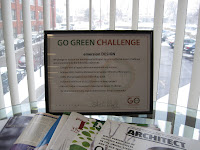This past weekend, several friends and I took a trip to Chicago. megabus ran a promotion for free seats, back in December, and we decided to take a 24-hour trip to the Windy City. I had plans to visit old standbys like Reckless Records, but also visit sustainable spots I found online. Unfortunately, our time ran short for running to Green Grocer Chicago, 360SEE, and Crop to Cup Coffee Company. I did, however, satiate my desire to find green assets in Chicago by doing photographic research for my upcoming presentations in Cincinnati neighborhoods.
The following are some new and old examples of recycling infrastructure in Chicago. Of course, these examples cannot be found all over the city, but they exhibit clear evidence of the power of partnerships.


Corporate-sponsored newspaper bins:
First is a basic newspaper recycling drop, which can be found in nearly all CTA transit stations, indoor and outdoor. Tied to Chicago's former Blue Bag Recycling Program, the bins originate from an agreement in 1997, between the Chicago Transit Authority and the Chicago Tribune. The newspaper provided the CTA funds to both purchase and install them in stations (link), which obviously resulted in advertising in prominent locations. Over the next year, 300 containers were placed at 90 stations. (The photo on the left, as you can see, does not have the feature the Tribune logo. I could not find evidence that reflected this change to the design of the newspaper bins.)
Currently, Cincinnati's Government Square does not currently have recycling bins installed at its bus bays. Perhaps Metro could benefit by leveraging partnerships with The Cincinnati Enquirer or Cincinnati CityBeat. In Cincinnati, we only have a single daily newspaper, which no longer has competition. (Business functions were actually handled by the Enquirer, since the Post entered a joint operating agreement in 1977.) Nonetheless, CityBeat and the Enquirer cater to opposing political views, and compete for ad revenue. As little ad space I have seen used above the seating on Metro buses, I believe that ad-supported or corporate sponsored recycling infrastructure is a great opportunity.


Ad-supported sidewalk recycling bins:
The bins pictured at the right were found in the Andersonville neighborhood of Chicago. After a visit to eco-andersonville.org, I found that the Andersonville Development Corporation formed a committee to develop the Eco-Andersonville initiative. The idea was to create a certification program designed scaled for small businesses. Their sustainability efforts now cover the following areas:
Sustainable Business Certification Program
Business district recycling
Energy audits
Green and sustainable events
Community and commercial composting research
The initial funding for the purchase and installation of the bins was made possible by a grant from the Illinois Department of Commerce and Economic Opportunity. Recycling collection is made possible by the sponsorship of its 15 bins. They illustrate the importance of leveraging public resources and private partnerships to create attractive public spaces. Additionally, the installation exhibits a wonderful visible sense of neighborhood pride. (Although the bins shown above accept only paper, Eco-Andersonville's bins line the business district to accept paper, plastic, aluminum, and glass.)
It should also be noted that eco-Andersonville's partnership with the Chicago Resource Center has made it possible to boast a 99% recycling rate in the neighborhood.
Instead of waiting for the city to fund and fulfill our sustainable visions, neighborhood community councils and development corporations can leverage resources and partnerships to create more sustainable urban corridors.

Book exchange bins:
And finally, just the for heck of it, how about book exchange bins? The installation of these bins, as was found outside Quimby's Books in Chicago's Wicker Park, can be as easy as salvaging non-functioning newspaper boxes. Where *did* all those Cincinnati Post boxes end up anyway, after the paper folded in 2007?
As we have seen over the past couple years, reuse and mobile markets have proven to be popular in several Cincinnati neighborhoods. Northside Up for Grabs, an annual "free market" enables anyone to bring unwanted items in exchange for others. The new Share Some Sugar -- a Cincinnati-based, online borrowing service -- also provides opportunities in the realm of waste reduction. Book exchanges can be a very inexpensive addition to a bustling neighborhood center.
































